An Improved Multimodal Biometric Identification System Employing Score-Level Fuzzification of Finger Texture and Finger Vein Biometrics
Abstract
:1. Introduction
- Universality means that all humans must have that characteristic in them.
- Distinctiveness means, for each individual, the characteristic must be present in some different form.
- Permanence shows that the biometric characteristic must remain invariable over a sufficient period.
- Collectability means the biometric characteristic must be quantifiable, such that it may be collected from human subjects.
- Performance shows the ability to identify human subjects on the basis of that characteristic.
- The degree of ease and obstructiveness defines the degree of the acceptability of the biometric modality.
- Circumvention describes the degree of difficulty required to launch a spoof attack to deceive the biometric-modality-based system.
- We employed a method of intensity optimization for the Near-Infra-Red Finger Vein images extracted from the NIRHI database. The experimental results show that intensity optimization improves the overall identification performance of the biometric system.
- We proposed an algorithm for processing the databases (NIR Hand Images database and acquired databases) to extract texture features and generate unimodal identification results based on the performed experiments.
- The proposed NIR Hand Images database and two on-request acquired databases were processed through three recently proposed pre-trained convolutional neural networks (AlexNet, VGG16 and VGG19) for having the identification accuracy parameters. The experimental results clearly show better performance accuracy for the unimodal biometric system.
- The proposed Fuzzy Rule-Based Inference system enhances the overall identification accuracy of the multimodal biometric system in comparison with individual identification accuracies.
2. Related Works
3. Methodology
3.1. Image Databases
3.1.1. Near-Infra-Red Hand Images Database (NIRHI)
3.1.2. Hong Kong Polytechnic University Database (HKPU)
3.1.3. University of Twente Finger Vein Pattern (UTFVP)
3.2. Finger Texture Biometric
3.2.1. Preprocessing
3.2.2. Linear Binary Pattern
3.2.3. Support Vector Machine
3.3. Finger Vein Biometric
3.3.1. Image Intensity Optimization
3.3.2. Image Transformation
3.3.3. Size Conversion and Transfer Learning
3.3.4. Architecture of Convolutional Neural Networks
4. Experimental Setup and Results
4.1. Finger Texture Biometric
4.1.1. NIRHI Database
4.1.2. HKPU Database
4.1.3. UTFVP Database
4.2. Finger Vein Biometric
4.2.1. Approach 1
- NIRHI Database:
- 2.
- HKPU Database:
- 3.
- UTFVP Database:
4.2.2. Approach 2
- NIRHI Database:
- 2.
- HKPU Database:
- 3.
- UTFVP Database:
4.3. Evaluation Metrics
4.4. Fuzzy Inference System
4.4.1. Fuzzification of the Finger Texture Biometric
4.4.2. Fuzzification of the Finger Vein Biometric
4.4.3. Fuzzification of the Output Confidence Score
4.4.4. Inference—Fuzzy Rules
- “input1==Low and input2== Moderate => output1=low_Confidence (1)”;
- “input1== below_Avg and input2== Moderate => output1=low_Confidence (1)”;
- “input1==Average and input2== Moderate => output1=high_Confidence (1)”;
- “input1==above_Avg and input2== Moderate => output1=high_Confidence (1)”;
- “input1==High and input2== Moderate => output1=high_Confidence (1)”.
4.4.5. Defuzzification
4.5. Capturing Training and Testing Times
5. Simulation and Discussion
5.1. Finger Texture Biometric
5.2. Finger Vein Biometric
5.3. Fuzzified Multimodal Biometric
5.3.1. Training Time vs. Accuracy
5.3.2. Testing Time vs. Accuracy
6. Comparative Analysis
6.1. Accuracy
6.2. Equal Error Rate
7. Conclusions
- The intensity optimization scheme positively affected the overall accuracy value. Hence, better accuracies were achieved for Approach 2 in comparison with Approach 1.
- Finger Texture features were extracted from NIR images in this research work. These extracted features are intrinsic and hence less vulnerable to the skin conditions of the subjects.
- The listed observed performance parameters in Table 3 show that the optimal sample size is 25 images per subject to achieve high accuracy values above 80% while having an optimal model training time. If the sample size is increased to 30 images per subject, there is a small variation in the achieved accuracy along with increases in the model training time. Therefore, 25 images per subject is an optimal sample size for the NIRHI database for the Finger Texture algorithm.
- It may be deduced from Table 4 that sample sizes of 24 images and 10 images per subject are optimal sample sizes for the HKPU and UTFVP databases, respectively, for the Finger Texture algorithm.
- A multimodal biometric system is proposed with a demonstrated high identification accuracy of 99.62% for the NIRHI database.
- The Fuzzy Rule-Based Inference system generated enhanced accuracy values for the multimodal system in comparison with the unimodal accuracies.
- It is concluded that the Finger Texture biometric algorithm results for the NIRHI database are better in terms of evaluation metrics compared to the results for the HKPU and UTFVP databases.
- Further, it is concluded that, for the Finger Vein biometric algorithm, AlexNet performed better in terms of evaluation metrics in comparison with VGG16 and VGG19 for Approaches 1 and 2.
- In addition to this, after comparative analysis, it is also concluded that NIRHI is a database that is capable of training and testing a biometric system based on Near-Infra-Red hand/finger images.
- It is also concluded that, due to optimal testing times, the proposed system may be used in real-time applications. Hence, real-life implementation is possible for the proposed system.
- The proposed system depends upon biometric modalities related to the human hand and fingers. A human subject that has some disability or injury related to hands or fingers will not be able to use this system.
- An NIR camera or camera with mounted NIR filters is expensive and may not be arranged without enough allocated funding. Therefore, it is an expensive system overall.
- Computers or laptops with installed graphical processing units are required for the training and testing of the CNN and SVM models. Therefore, high-performance computational resources are also required, which are also expensive.
- As the proposed system employs NIR images, and due to the intrinsic nature of the features present in the input images, the capability to resist any imposter attack is enhanced exponentially. In the future, the proposed system may be evaluated for its capability to observe and quantify different imposter attacks.
- Some medical issues generally found in elderly subjects, like vein thrombosis and connective tissue diseases, may affect Finger Vein patterns. Moreover, during a period, registered subjects may have some injuries resulting in damage or changes in Finger Vein and Finger Texture features. This change in biometric features may increase the False Rejection Rate and decrease reliability. This behavior of change in Finger Vein structure may be observed, and some predictions and remedies may be suggested in future work.
- Performance variations in the proposed system due to environmental variability (like changes in room temperature, etc.) and subject diversity (like gender, age factor, etc.) may be observed in future research work.
Author Contributions
Funding
Institutional Review Board Statement
Informed Consent Statement
Data Availability Statement
Acknowledgments
Conflicts of Interest
References
- Sarhan, S.; Alhassan, S.; Elmougy, S. Multimodal Biometric Systems: A Comparative Study. Arab. J. Sci. Eng. 2017, 42, 443–457. [Google Scholar] [CrossRef]
- Xie, C.; Kumar, A. Finger Vein Identification Using Convolutional Neural Network and Supervised Discrete Hashing. Pattern Recognit. Lett. 2019, 119, 148–156. [Google Scholar] [CrossRef]
- Haider, S.A.; Rehman, Y.; Ali, S.M.U. Enhanced Multimodal Biometric Recognition Based upon Intrinsic Hand Biometrics. Electronics 2020, 9, 1916. [Google Scholar] [CrossRef]
- Tirunagari, S.; Poh, N.; Bober, M.; Windridge, D. Windowed DMD as a Microtexture Descriptor for Finger Vein Counter-Spoofing in Biometrics. In Proceedings of the 2015 IEEE International Workshop on Information Forensics and Security (WIFS), Rome, Italy, 16–19 November 2015; IEEE: Piscataway, NJ, USA, 2015; pp. 1–6. [Google Scholar]
- Raghavendra, R.; Busch, C. Presentation Attack Detection Algorithms for Finger Vein Biometrics: A Comprehensive Study. In Proceedings of the 2015 11th International Conference on Signal-Image Technology & Internet-Based Systems (SITIS), Bangkok, Thailand, 23–27 November 2015; IEEE: Piscataway, NJ, USA, 2015; pp. 628–632. [Google Scholar]
- Qiu, X.; Kang, W.; Tian, S.; Jia, W.; Huang, Z. Finger Vein Presentation Attack Detection Using Total Variation Decomposition. IEEE Trans. Inf. Forensics Secur. 2017, 13, 465–477. [Google Scholar] [CrossRef]
- Raghavendra, R.; Avinash, M.; Marcel, S.; Busch, C. Finger Vein Liveness Detection Using Motion Magnification. In Proceedings of the 2015 IEEE 7th International Conference on Biometrics Theory, Applications and Systems (BTAS), Arlington, VA, USA, 8–11 September 2015; IEEE: Piscataway, NJ, USA, 2015; pp. 1–7. [Google Scholar]
- Tome, P.; Raghavendra, R.; Busch, C.; Tirunagari, S.; Poh, N.; Shekar, B.H.; Gragnaniello, D.; Sansone, C.; Verdoliva, L.; Marcel, S. The 1st Competition on Counter Measures to Finger Vein Spoofing Attacks. In Proceedings of the 2015 International Conference on Biometrics (ICB), Phuket, Thailand, 19–22 May 2015; IEEE: Piscataway, NJ, USA, 2015; pp. 513–518. [Google Scholar]
- Park, Y.H.; Park, K.R. Image Quality Enhancement Using the Direction and Thickness of Vein Lines for Finger-Vein Recognition. Int. J. Adv. Robot. Syst. 2012, 9, 154. [Google Scholar] [CrossRef]
- Zhang, J.; Yang, J. Finger-Vein Image Enhancement Based on Combination of Gray-Level Grouping and Circular Gabor Filter. In Proceedings of the 2009 International Conference on Information Engineering and Computer Science, Wuhan, China, 19–20 December 2009; IEEE: Piscataway, NJ, USA, 2009; pp. 1–4. [Google Scholar]
- Yang, J.; Yang, J. Multi-Channel Gabor Filter Design for Finger-Vein Image Enhancement. In Proceedings of the 2009 Fifth International Conference on Image and Graphics, Xian, China, 20–23 September 2009; IEEE: Piscataway, NJ, USA, 2009; pp. 87–91. [Google Scholar]
- Pi, W.; Shin, J.; Park, D. An Effective Quality Improvement Approach for Low Quality Finger Vein Image. In Proceedings of the 2010 International Conference on Electronics and Information Engineering, Kyoto, Japan, 1–3 August 2010; IEEE: Piscataway, NJ, USA, 2010; Volume 1, p. V1-424. [Google Scholar]
- Yang, J.; Zhang, X. Feature-Level Fusion of Global and Local Features for Finger-Vein Recognition. In Proceedings of the IEEE 10th International Conference on Signal Processing Proceedings, Beijing, China, 24–28 October 2010; IEEE: Piscataway, NJ, USA, 2010; pp. 1702–1705. [Google Scholar]
- Yu, C.-B.; Zhang, D.-M.; Li, H.-B.; Zhang, F.-F. Finger-Vein Image Enhancement Based on Muti-Threshold Fuzzy Algorithm. In Proceedings of the 2009 2nd International Congress on Image and Signal Processing, Tianjin, China, 17–19 October 2009; IEEE: Piscataway, NJ, USA, 2009; pp. 1–3. [Google Scholar]
- Shin, K.Y.; Park, Y.H.; Nguyen, D.T.; Park, K.R. Finger-Vein Image Enhancement Using a Fuzzy-Based Fusion Method with Gabor and Retinex Filtering. Sensors 2014, 14, 3095–3129. [Google Scholar] [CrossRef]
- Das, R.; Piciucco, E.; Maiorana, E.; Campisi, P. Convolutional Neural Network for Finger-Vein-Based Biometric Identification. IEEE Trans. Inf. Forensics Secur. 2019, 14, 360–373. [Google Scholar] [CrossRef]
- Lv, G.-L.; Shen, L.; Yao, Y.-D.; Wang, H.-X.; Zhao, G.-D. Feature-Level Fusion of Finger Vein and Fingerprint Based on a Single Finger Image: The Use of Incompletely Closed Near-Infrared Equipment. Symmetry 2020, 12, 709. [Google Scholar] [CrossRef]
- Bok, J.Y.; Suh, K.H.; Lee, E.C. Detecting Fake Finger-Vein Data Using Remote Photoplethysmography. Electronics 2019, 8, 1016. [Google Scholar] [CrossRef]
- Yao, Q.; Song, D.; Xu, X. Robust Finger-Vein ROI Localization Based on the 3σ Criterion Dynamic Threshold Strategy. Sensors 2020, 20, 3997. [Google Scholar] [CrossRef]
- Kim, W.; Song, J.M.; Park, K.R. Multimodal Biometric Recognition Based on Convolutional Neural Network by the Fusion of Finger-Vein and Finger Shape Using Near-Infrared (NIR) Camera Sensor. Sensors 2018, 18, 2296. [Google Scholar] [CrossRef]
- Alay, N.; Al-Baity, H.H. Deep Learning Approach for Multimodal Biometric Recognition System Based on Fusion of Iris, Face, and Finger Vein Traits. Sensors 2020, 20, 5523. [Google Scholar] [CrossRef]
- Bernacki, K.; Moroń, T.; Popowicz, A. Modified Distance Transformation for Image Enhancement in NIR Imaging of Finger Vein System. Sensors 2020, 20, 1644. [Google Scholar] [CrossRef]
- Xie, C.; Kumar, A. Finger Vein Identification Using Convolutional Neural Network and Supervised Discrete Hashing. In Deep Learning for Biometrics; Springer: Berlin/Heidelberg, Germany, 2017; pp. 109–132. [Google Scholar]
- Ali, S.I.; Lalji, S.M.; Haider, S.A.; Haneef, J.; Syed, A.-H.; Husain, N.; Yahya, A.; Rashid, Z.; Arfeen, Z.A. Risk Prioritization in a Core Preparation Experiment Using Fuzzy VIKOR Integrated with Shannon Entropy Method. Ain Shams Eng. J. 2024, 15, 102421. [Google Scholar] [CrossRef]
- Hong, H.G.; Lee, M.B.; Park, K.R. Convolutional Neural Network-Based Finger-Vein Recognition Using NIR Image Sensors. Sensors 2017, 17, 1297. [Google Scholar] [CrossRef]
- mehdi Cherrat, E.; Alaoui, R.; Bouzahir, H. Convolutional Neural Networks Approach for Multimodal Biometric Identification System Using the Fusion of Fingerprint, Finger-Vein and Face Images. PeerJ Comput. Sci. 2020, 6, e248. [Google Scholar] [CrossRef]
- He, B.; Shen, L.; Wang, H.; Yao, Y.; Zhao, G. Finger Vein De-Noising Algorithm Based on Custom Sample-Texture Conditional Generative Adversarial Nets. Neural Process. Lett. 2021, 53, 4279–4292. [Google Scholar] [CrossRef]
- Bharathi, S.; Sudhakar, R. Biometric Recognition Using Finger and Palm Vein Images. Soft Comput. 2019, 23, 1843–1855. [Google Scholar] [CrossRef]
- Zhou, C.; Huang, J.; Yang, F.; Liu, Y. A Hybrid Fusion Model of Iris, Palm Vein and Finger Vein for Multi-Biometric Recognition System. Multimed. Tools Appl. 2020, 79, 29021–29042. [Google Scholar] [CrossRef]
- Shaheed, K.; Mao, A.; Qureshi, I.; Kumar, M.; Hussain, S.; Ullah, I.; Zhang, X. DS-CNN: A Pre-Trained Xception Model Based on Depth-Wise Separable Convolutional Neural Network for Finger Vein Recognition. Expert Syst. Appl. 2022, 191, 116288. [Google Scholar] [CrossRef]
- Kumar, A.; Zhou, Y. Human Identification Using Finger Images. IEEE Trans. Image Process. 2011, 21, 2228–2244. [Google Scholar] [CrossRef] [PubMed]
- Ton, B.T.; Veldhuis, R.N.J. A High Quality Finger Vascular Pattern Dataset Collected Using a Custom Designed Capturing Device. In Proceedings of the 2013 International Conference on Biometrics (ICB), Madrid, Spain, 4–7 June 2013; pp. 1–5. [Google Scholar]
- Tome, P.; Vanoni, M.; Marcel, S. On the Vulnerability of Finger Vein Recognition to Spoofing. In Proceedings of the 2014 International Conference of the Biometrics Special Interest Group (BIOSIG), Darmstadt, Germany, 10–12 September 2014; pp. 1–10. [Google Scholar]
- Krizhevsky, A.; Sutskever, I.; Hinton, G.E. ImageNet Classification with Deep Convolutional Neural Networks. Commun. ACM 2017, 60, 84–90. [Google Scholar] [CrossRef]
- Karen Simonyan, A.Z. Very Deep Convolutional Networks for Large-Scale Image Recognition. arXiv 2014, arXiv:1409.1556. [Google Scholar]
- Russakovsky, O.; Deng, J.; Su, H.; Krause, J.; Satheesh, S.; Ma, S.; Huang, Z.; Karpathy, A.; Khosla, A.; Bernstein, M.; et al. ImageNet Large Scale Visual Recognition Challenge. Int. J. Comput. Vis. 2015, 115, 211–252. [Google Scholar] [CrossRef]

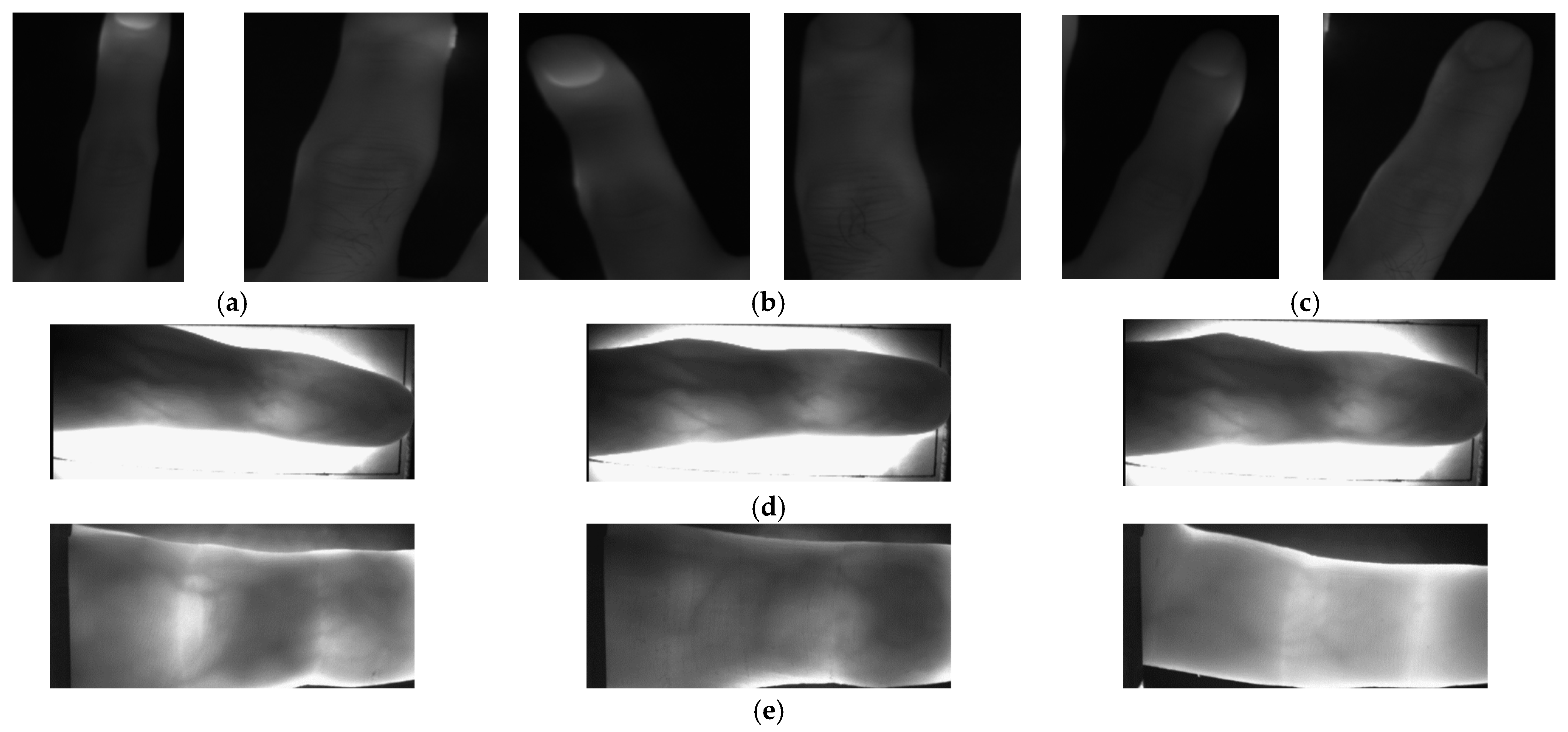
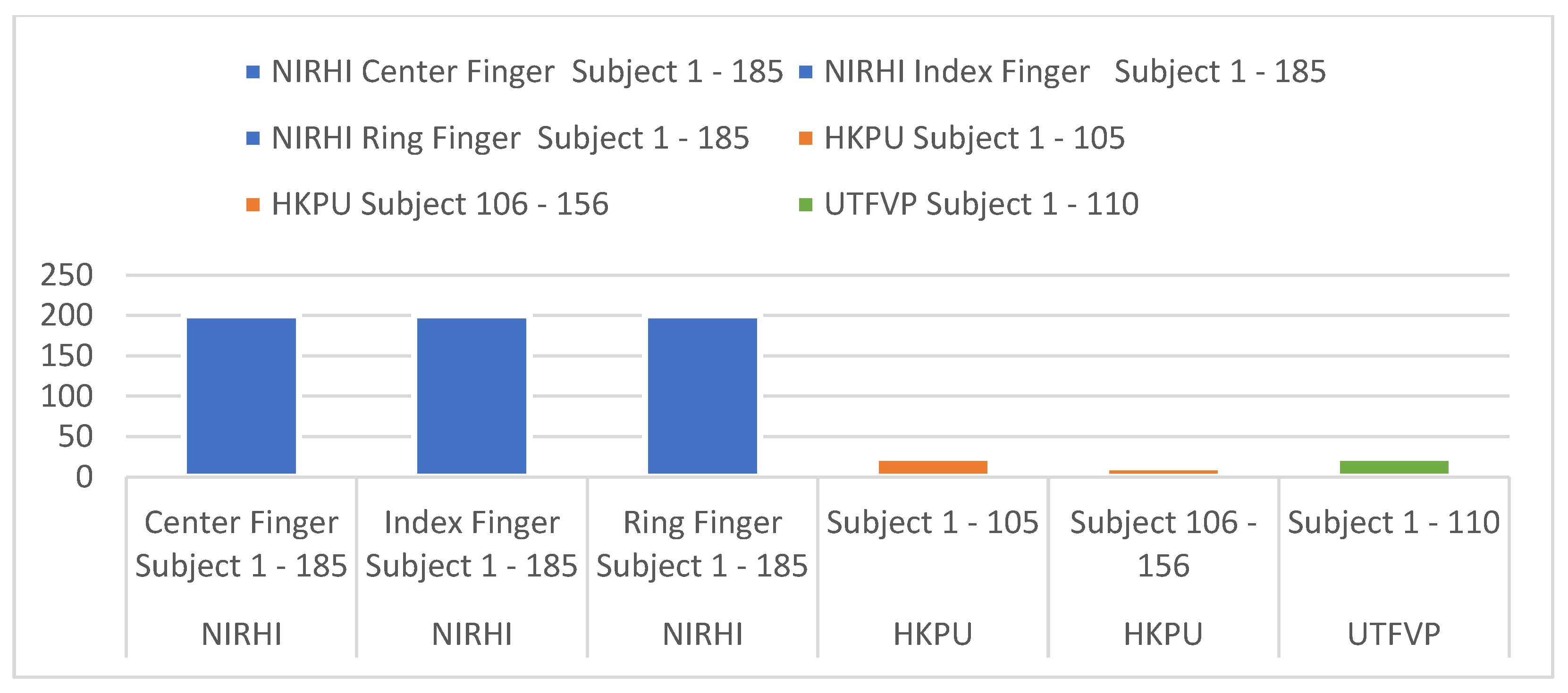
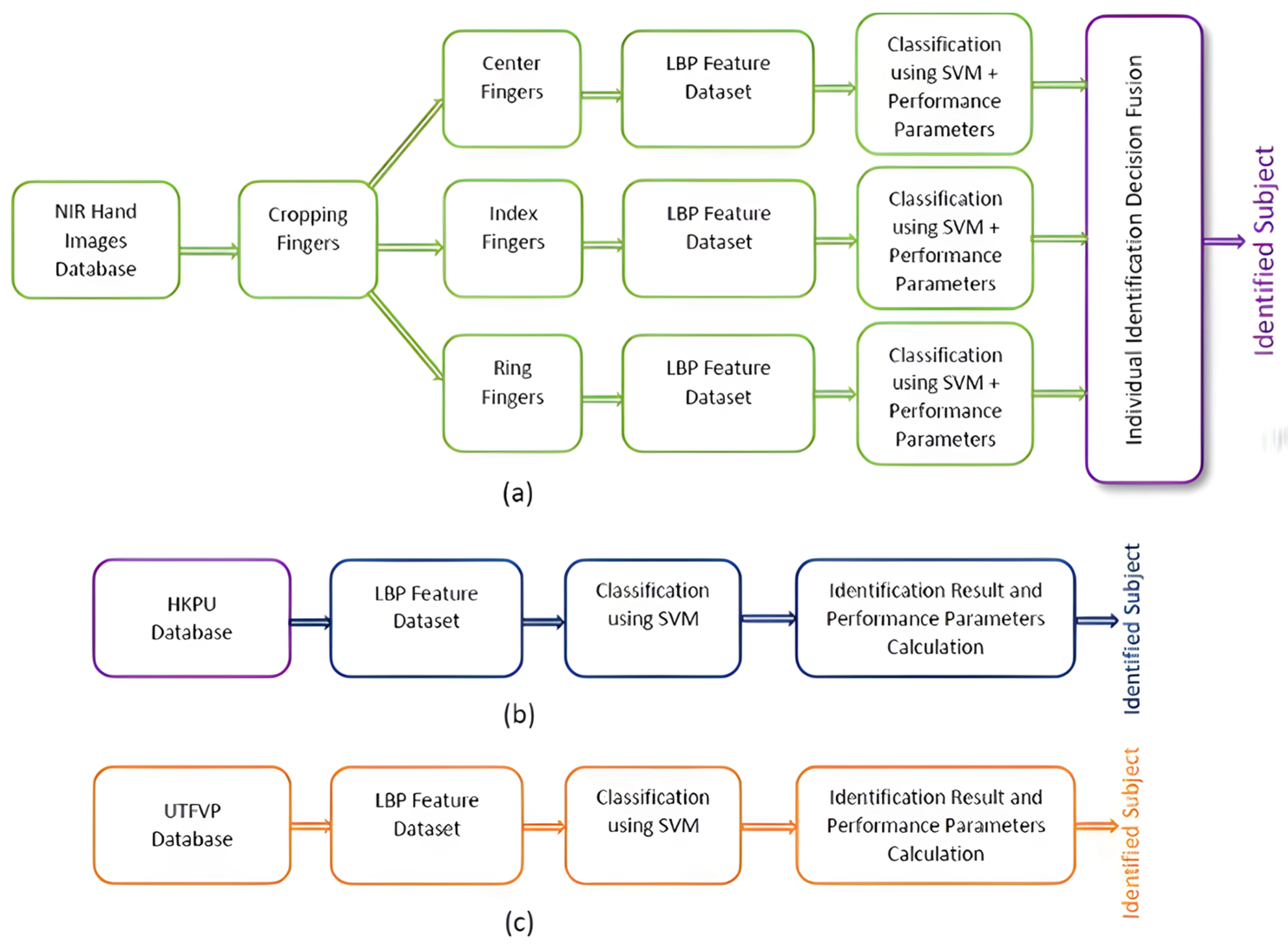
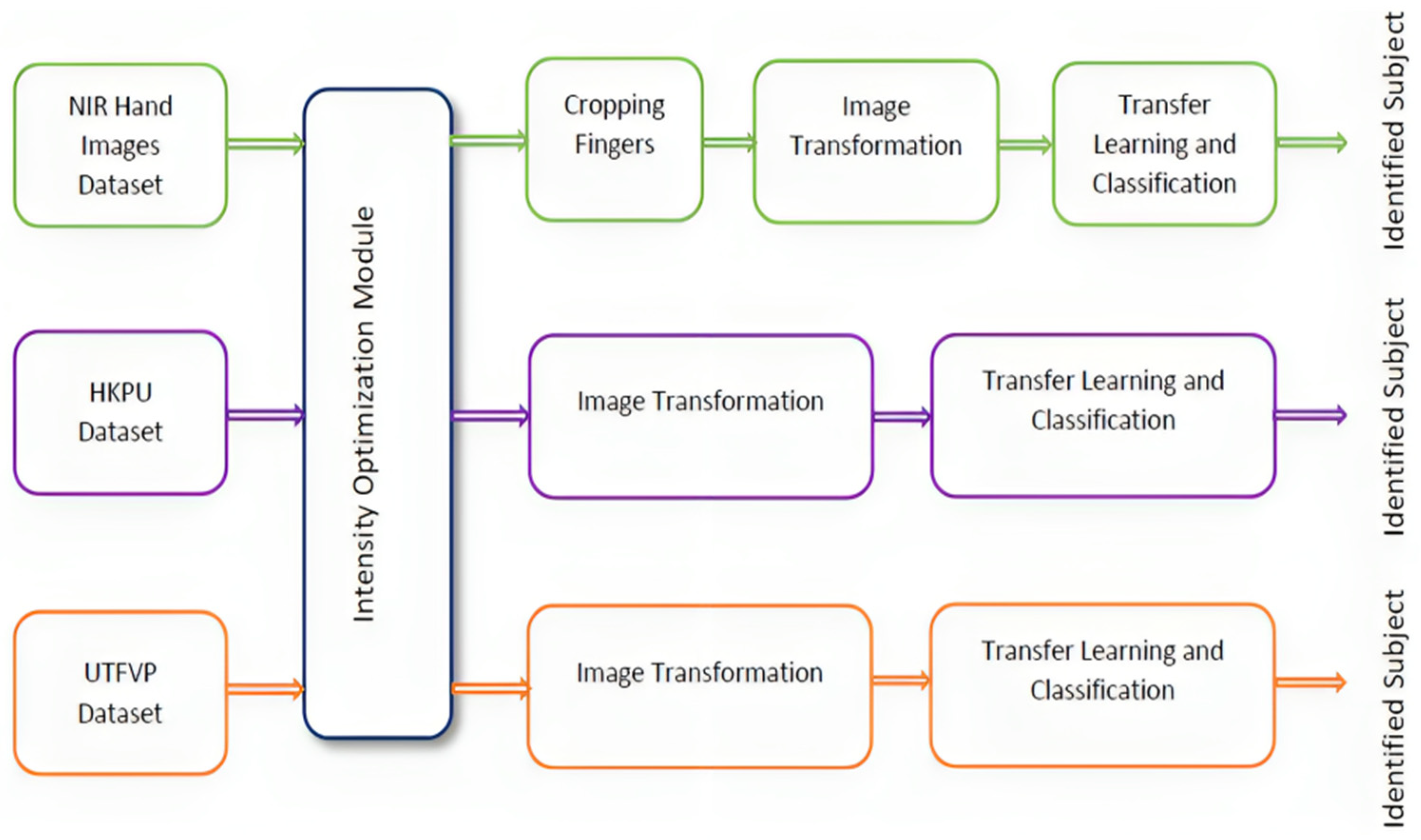

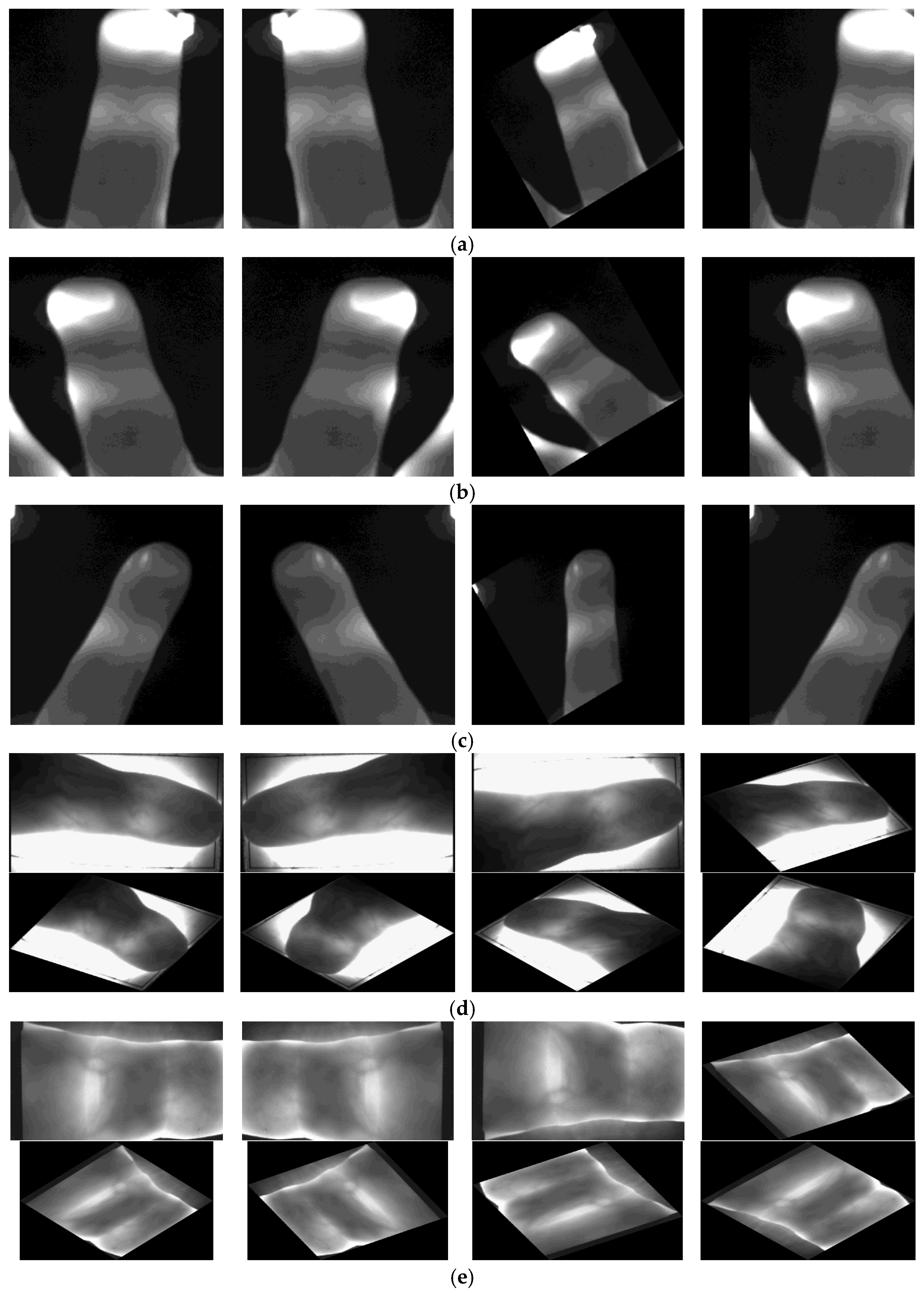


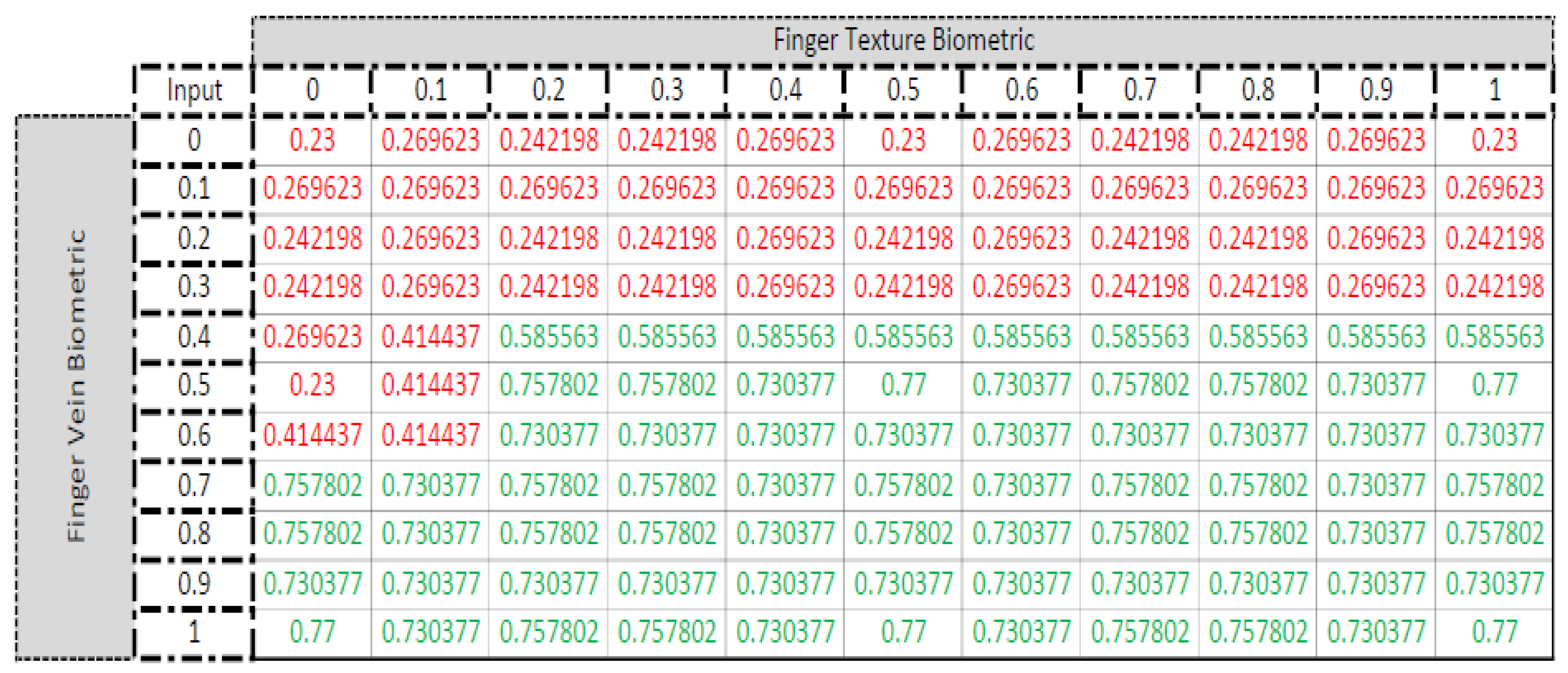





| Cited Articles | Modalities Employed | Methodology and Shortcomings | Reported Evaluation Metrics and ROC Curves |
|---|---|---|---|
| [3] | 1. Finger Vein 2. Hand Geometry 3. Pulse Response | CNN model training and testing for Finger Veins, Handcrafted technique for Hand Geometry, Fuzzy Fusion for the final result, EER was not reported. | Accuracy, Precision, Recall, FAR vs. GAR, Threshold vs. FAR/FRR |
| [17] | 1. Finger Vein 2. Fingerprints | Feature-level fusion, LBP for feature extraction and SVM as the classifier, Accuracy, FRR, Precision and Recall were not reported. May only handle small datasets. | FAR, Recognition Rate |
| [20] | 1. Finger Vein 2. Fingerprint | CNN models, score-level fusion for identification results, Accuracy, Precision and Recall were not reported. | FAR vs. GAR, EER |
| [21] | 1. Iris 2. Face 3. Finger Vein | CNN models, feature- and score-level fusion, FAR, FRR, EER, training and testing times were not reported. | Accuracy, Rank vs. Recognition Rate |
| [26] | 1. Finger Vein 2. Fingerprint 3. Face | Random forest classifier, softmax function and CNN were used for Finger Veins, faces and fingerprints, score-level fusion was implemented. No other metric was reported except Accuracy. | Accuracy |
| [28] | 1. Finger Vein 2. Palm Vein | 2D Gabor Filter, Gradient Filter was used for feature extraction, Fuzzy score-level fusion was used. Precision, Recall, etc., were not reported. | Accuracy, Threshold vs. FRR, FRR vs. FAR, EER |
| [29] | 1. Iris 2. Palm Vein 3. Finger Vein | The best from the Gabor Filter, LBP, LDA, PCA was used for feature extraction, feature-level, decision-level and hybrid fusion were proposed. Precision, Recall, etc., were not reported. | Accuracy, Recognition Rate graphs were reported |
| Actual ↓\Predicted → | Positive | Negative |
|---|---|---|
| True | True Positive (TP) | True Negative (TN) |
| False | False Positive (FP) | False Negative (FN) |
| Sample Size | Performance Parameter | Center Finger | Index Finger | Ring Finger |
|---|---|---|---|---|
| 30 | Accuracy | 83.6036 | 81.9820 | 89.8919 |
| Model Training Time (s) | 17,033.4894 | 15,657.2421 | 10,176.6519 | |
| Function Evaluation Time (s) | 387.2414 | 335.1072 | 754.9668 | |
| Precision | 0.8331 | 0.8227 | 0.8156 | |
| Recall (True Positive Rate) | 0.8232 | 0.8163 | 0.8076 | |
| F1 Score | 0.8281 | 0.8195 | 0.8116 | |
| True Negative Rate | 0.9990 | 0.9990 | 0.9990 | |
| False Positive Rate | 9.6088 × 10−4 | 9.9270 × 10−4 | 0.0010 | |
| False Negative Rate | 0.1768 | 0.1827 | 0.1921 | |
| 25 | Accuracy | 86.8108 | 83.0270 | 80 |
| Model Training Time (s) | 13,647.683 | 9973.0583 | 9855.4196 | |
| Function Evaluation Time (s) | 294.6148 | 312.2454 | 367.9968 | |
| Precision | 0.8625 | 0.8304 | 0.8217 | |
| Recall (True Positive Rate) | 0.8576 | 0.8209 | 0.8116 | |
| F1 Score | 0.8600 | 0.8256 | 0.8166 | |
| True Negative Rate | 0.9992 | 0.9990 | 0.9990 | |
| False Positive Rate | 7.7409 × 10−4 | 9.6651 × 10−4 | 0.0010 | |
| False Negative Rate | 0.1424 | 0.1778 | 0.1868 | |
| 20 | Accuracy | 56.8919 | 58.2432 | 47.4324 |
| Model Training Time (s) | 4727.9013 | 7874.1529 | 8758.2269 | |
| Function Evaluation Time (s) | 166.4988 | 270.3589 | 303.5633 | |
| Precision | 0.6409 | 0.6230 | 0.4618 | |
| Recall (True Positive Rate) | 0.6146 | 0.5899 | 0.4424 | |
| F1 Score | 0.6275 | 0.606 | 0.4519 | |
| True-Negative Rate | 0.9974 | 0.9972 | 0.9962 | |
| False Positive Rate | 0.0026 | 0.0028 | 0.0038 | |
| False Negative Rate | 0.3804 | 0.4084 | 0.5547 |
| Sample Size (HKPU) | Performance Parameter | Evaluation Metrics | Sample Size (UTFVP) | Performance Parameter | Evaluation Metrics |
|---|---|---|---|---|---|
| 24 | Accuracy | 25.6342 | 12 | Accuracy | 62.8788 |
| Model Training Time (s) | 40,930.4645 | Model Training Time (s) | 2170.757 | ||
| Function Evaluation Time (s) | 3583.3136 | Function Evaluation Time (s) | 96.9479 | ||
| Precision | 0.2672 | Precision | 0.5952 | ||
| Recall (True Positive Rate) | 0.2737 | Recall (True Positive Rate) | 0.5778 | ||
| F1 Score | 0.2704 | F1 Score | 0.5864 | ||
| True Negative Rate | 0.9953 | True Negative Rate | 0.9962 | ||
| False Positive Rate | 0.0047 | False Positive Rate | 0.0038 | ||
| False Negative Rate | 0.7226 | False Negative Rate | 0.4148 | ||
| 22 | Accuracy | 19.0962 | 10 | Accuracy | 72.2727 |
| Model Training Time (s) | 18,611.9825 | Model Training Time (s) | 1917.2405 | ||
| Function Evaluation Time (s) | 2121.2213 | Function Evaluation Time (s) | 83.7306 | ||
| Precision | 0.1523 | Precision | 0.6581 | ||
| Recall (True Positive Rate) | 0.1784 | Recall (True Positive Rate) | 0.6461 | ||
| F1 Score | 0.1643 | F1 Score | 0.6520 | ||
| True Negative Rate | 0.9947 | True Negative Rate | 0.9969 | ||
| False Positive Rate | 0.0053 | False Positive Rate | 0.0031 | ||
| False Negative Rate | 0.8230 | False Negative Rate | 0.3420 | ||
| 20 | Accuracy | 17.3077 | 8 | Accuracy | 77.2727 |
| Model Training Time (s) | 7458.5968 | Model Training Time (s) | 1971.2457 | ||
| Function Evaluation Time (s) | 720.7739 | Function Evaluation Time (s) | 104.3346 | ||
| Precision | 0.1480 | Precision | 0.7691 | ||
| Recall (True Positive Rate) | 0.1623 | Recall (True Positive Rate) | 0.7588 | ||
| F1 Score | 0.1548 | F1 Score | 0.7639 | ||
| True Negative Rate | 0.9946 | True Negative Rate | 0.9980 | ||
| False Positive Rate | 0.0054 | False Positive Rate | 0.0020 | ||
| False Negative Rate | 0.8349 | False Negative Rate | 0.2145 |
| Databases | Performance Parameters | Approach 1 | Approach 2 | ||||
|---|---|---|---|---|---|---|---|
| AlexNet | VGG16 | VGG19 | AlexNet | VGG16 | VGG19 | ||
| NIRHI | Accuracy | 95.29% | 93.40% | 91.13% | 96.96% | 96.57% | 95.86% |
| Precision | 95.29% | 93.40% | 91.13% | 96.95% | 96.57% | 95.86% | |
| Recall | 95.29% | 93.40% | 91.13% | 96.95% | 96.57% | 95.86% | |
| False Positive Rate | 4.59 × 10−4 | 8.90 × 10−3 | 5.60 × 10−3 | 2.75 × 10−6 | 2.34 × 10−5 | 6.3 × 10−4 | |
| True Negative Rate | 99.75% | 99.49% | 99.17% | 100% | 100% | 100% | |
| False Negative Rate | 1.56 × 10−3 | 0.0012 | 0.0026 | 5.07 × 10−4 | 0.0043 | 0.0065 | |
| HKPU | Accuracy | 81.93% | 89.01% | 87.65% | 89.68% | 92.53% | 90.04% |
| Precision | 81.93% | 89.01% | 87.65% | 89.68% | 92.53% | 90.04% | |
| Recall | 81.93% | 89.01% | 87.65% | 89.68% | 92.53% | 90.04% | |
| False Positive Rate | 0.0012 | 7.09 × 10−4 | 3.57 × 10−3 | 0.0021 | 3.92 × 10−3 | 5.09 × 10−3 | |
| True Negative Rate | 99.88% | 99.93% | 99.95% | 98.87% | 99.27% | 99.32% | |
| False Negative Rate | 0.1807 | 0.1099 | 0.134 | 0.0561 | 0.0086 | 0.0103 | |
| UTFVP | Accuracy | 78.79% | 79.12% | 80.70% | 83.79% | 82.25% | 85.08% |
| Precision | 79.52% | 79.12% | 80.70% | 83.79% | 82.25% | 85.08% | |
| Recall | 80.12% | 79.12% | 80.70% | 83.79% | 82.25% | 85.08% | |
| False Positive Rate | 0.0017 | 0.0019 | 0.0022 | 0.0025 | 0.0029 | 0.0034 | |
| True Negative Rate | 99.83% | 99.81% | 99.79% | 98.56% | 98.14% | 98.02% | |
| False Negative Rate | 0.1988 | 0.2088 | 0.201 | 0.1568 | 0.182 | 0.1692 | |
| Basic Definitions | Inputs and Output | Rules |
|---|---|---|
| [System] Name=‘FIS_2′ Type=‘mamdani’ Version=2.0 NumInputs=2 NumOutputs=1 NumRules=25 AndMethod=‘min’ OrMethod=‘max’ ImpMethod=‘min’ AggMethod=‘max’ DefuzzMethod=‘centroid’ | [Input1] Name=‘FingerTexture’ Range=[0 1] NumMFs=5 MF1=‘Low’:’trimf’,[−0.2 0 0.2] MF2=‘below_Avg’:’trimf’,[0.05 0.25 0.45] MF3=‘Average’:’trimf’,[0.3 0.5 0.7] MF4=‘High’:’trimf’,[0.8 1 1.2] MF5=‘above_Avg’:’trimf’,[0.55 0.75 0.95] [Input2] Name=‘FingerVein’ Range=[0 1] NumMFs=5 MF1=‘very_Poor’:’trimf’,[−0.2 0 0.2] MF2=‘Poor’:’trimf’,[0.05 0.25 0.45] MF3=‘Moderate’:’trimf’,[0.3 0.5 0.7] MF4=‘very_Strong’:’trimf’,[0.8 1 1.2] MF5=‘Strong’:’trimf’,[0.55 0.75 0.95] [Output1] Name=‘Confidence_Level’ Range=[0 1] NumMFs=2 MF1=‘high_Confidence’:’trimf’,[0.3 1 1.6] MF2=‘low_Confidence’:’trimf’,[−0.7 0 0.7] | [Rules] 1 1, 2 (1) : 1 1 2, 2 (1) : 1 1 3, 2 (1) : 1 1 4, 1 (1) : 1 1 5, 1 (1) : 1 2 1, 2 (1) : 1 2 2, 2 (1) : 1 2 3, 1 (1) : 1 2 4, 1 (1) : 1 2 5, 1 (1) : 1 3 1, 2 (1) : 1 3 2, 2 (1) : 1 3 3, 1 (1) : 1 3 4, 1 (1) : 1 3 5, 1 (1) : 1 4 1, 2 (1) : 1 4 2, 2 (1) : 1 4 3, 1 (1) : 1 4 4, 1 (1) : 1 4 5, 1 (1) : 1 5 1, 2 (1) : 1 5 2, 2 (1) : 1 5 3, 1 (1) : 1 5 4, 1 (1) : 1 5 5, 1 (1) : 1 |
| Modality | Accuracy | Precision | Recall | ||||||
|---|---|---|---|---|---|---|---|---|---|
| NIRHI | HKPU | UTFVP | NIRHI | HKPU | UTFVP | NIRHI | HKPU | UTFVP | |
| Finger Texture | 86.81% | 25.63% | 77.27% | 86.25% | 26.71% | 76.91% | 85.76% | 27.37% | 75.88% |
| Finger Vein | 96.96% | 92.53% | 85.08% | 96.95% | 92.53% | 85.08% | 96.95% | 92.53% | 85.08% |
| Multimodal | 99.62% | 92.95% | 86.32% | 98.12% | 91.30% | 83.86% | 99.47% | 91.49% | 83.93% |
Disclaimer/Publisher’s Note: The statements, opinions and data contained in all publications are solely those of the individual author(s) and contributor(s) and not of MDPI and/or the editor(s). MDPI and/or the editor(s) disclaim responsibility for any injury to people or property resulting from any ideas, methods, instructions or products referred to in the content. |
© 2023 by the authors. Licensee MDPI, Basel, Switzerland. This article is an open access article distributed under the terms and conditions of the Creative Commons Attribution (CC BY) license (https://creativecommons.org/licenses/by/4.0/).
Share and Cite
Haider, S.A.; Ashraf, S.; Larik, R.M.; Husain, N.; Muqeet, H.A.; Humayun, U.; Yahya, A.; Arfeen, Z.A.; Khan, M.F. An Improved Multimodal Biometric Identification System Employing Score-Level Fuzzification of Finger Texture and Finger Vein Biometrics. Sensors 2023, 23, 9706. https://doi.org/10.3390/s23249706
Haider SA, Ashraf S, Larik RM, Husain N, Muqeet HA, Humayun U, Yahya A, Arfeen ZA, Khan MF. An Improved Multimodal Biometric Identification System Employing Score-Level Fuzzification of Finger Texture and Finger Vein Biometrics. Sensors. 2023; 23(24):9706. https://doi.org/10.3390/s23249706
Chicago/Turabian StyleHaider, Syed Aqeel, Shahzad Ashraf, Raja Masood Larik, Nusrat Husain, Hafiz Abdul Muqeet, Usman Humayun, Ashraf Yahya, Zeeshan Ahmad Arfeen, and Muhammad Farhan Khan. 2023. "An Improved Multimodal Biometric Identification System Employing Score-Level Fuzzification of Finger Texture and Finger Vein Biometrics" Sensors 23, no. 24: 9706. https://doi.org/10.3390/s23249706
APA StyleHaider, S. A., Ashraf, S., Larik, R. M., Husain, N., Muqeet, H. A., Humayun, U., Yahya, A., Arfeen, Z. A., & Khan, M. F. (2023). An Improved Multimodal Biometric Identification System Employing Score-Level Fuzzification of Finger Texture and Finger Vein Biometrics. Sensors, 23(24), 9706. https://doi.org/10.3390/s23249706










